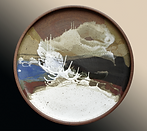
Studio S
P O T T E R Y
WELCOME!
Scroll Down For Additional Information
Definition
The firing of clay refers to the process of adding heat to clay after it has air dryed. When the water has evaporated from between the clay particles, and all the remaining clay particles are in contact, drying shrinkage is complete, (leather hard stage). Complete drying takes place in the kiln when it reaches 212°F. This should happen slowly or steam will form in the clay and cause it to blow up or explode.
Dehydration occurs at 662° F where the chemically combined water of the clay is driven off and is completed by 932°F. Clay will not remix with water after this point. The burn off is the next occurrence in the firing process when the temperature reaches 1650°F. At this stage the organic and the inorganic materials such as carbonates and sulfates burn out--you will smell the fumes.
After dehydration, the next event is quartz inversion, which happens at 1064°F. At this point the quartz crystals rearrange themselves into a slightly different order and temporarily increase in volume. Cracking is more likely to occur at this stage.
Vitrification is the next step of the firing process. This is the hardening and tightening and partial glassification of the clay. It is the fusion or melting of various components of the clay. Final shrinkage of the clay takes place at vitrification. Clays vitrifies at various temperatures depending on their compositions. Red clays high in iron vitrify at 1850°F to Kaolins at 3300°F. All go through these stages when fired to maturity.

Lewis & Eric Snyder